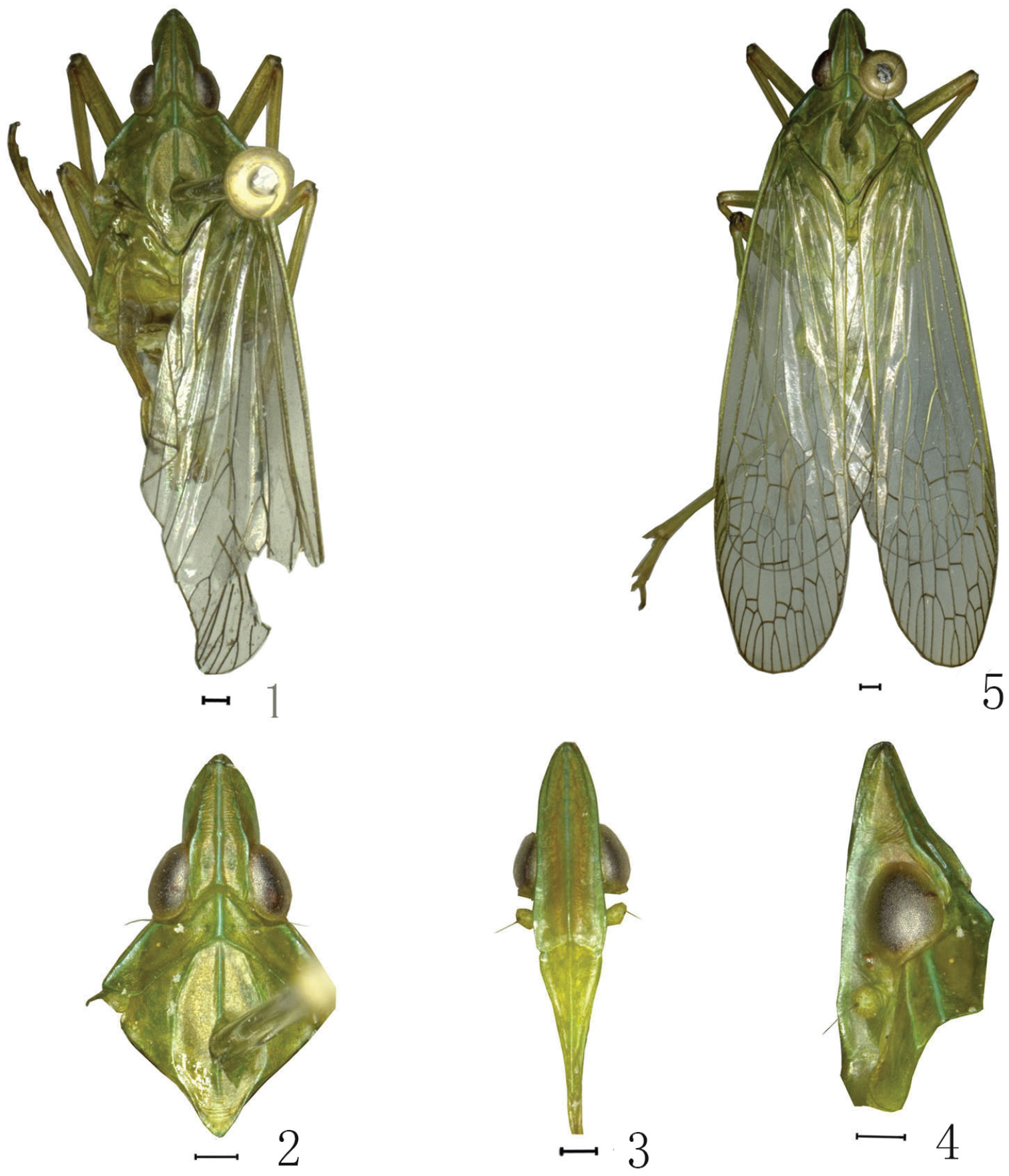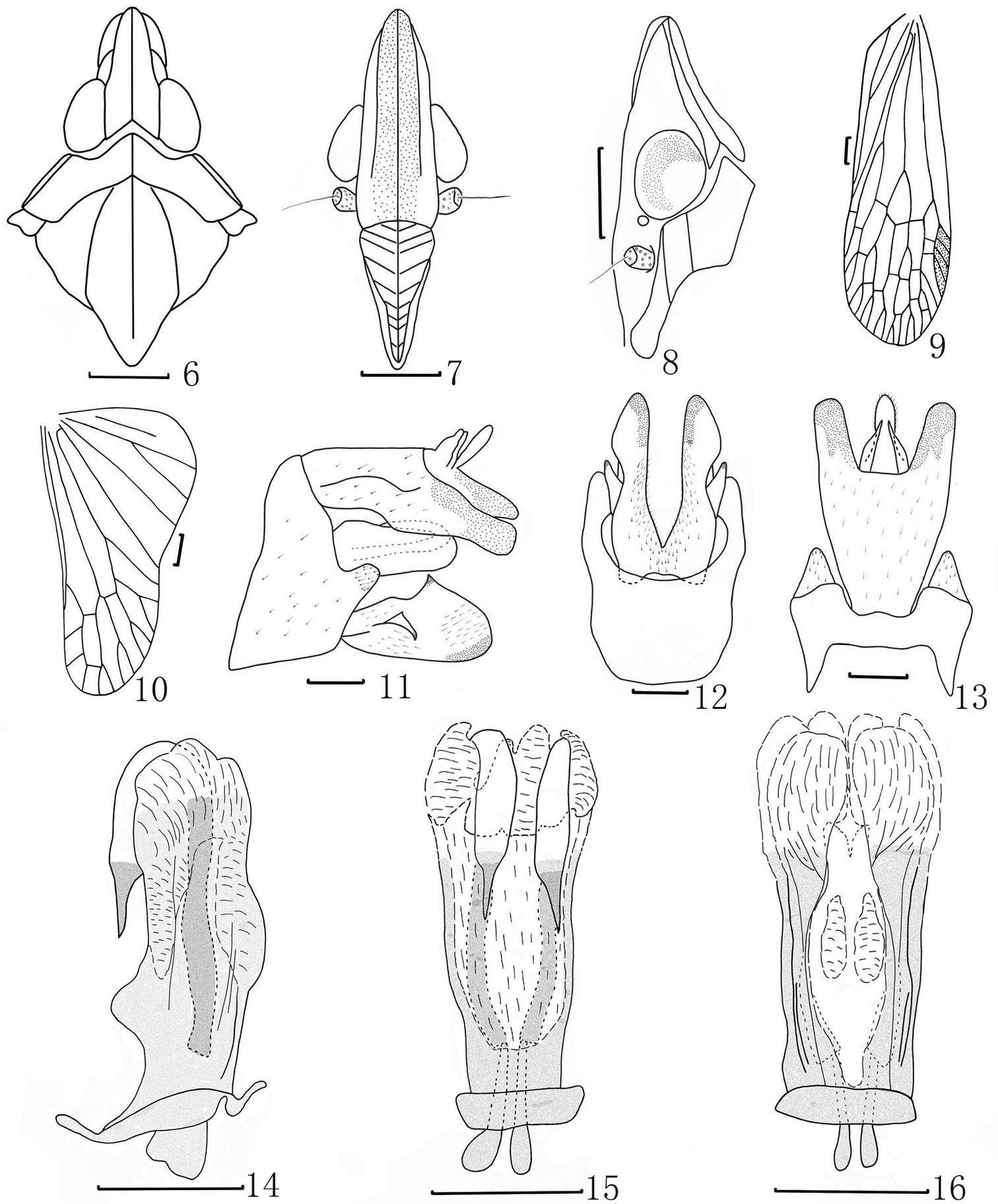






Citation: Zheng Y-L, Chen X-S (2014) A new species of Dictyotenguna Song & Liang, 2012 from China (Hemiptera, Fulgoromorpha, Dictyopharidae). ZooKeys 429: 63–68. doi: 10.3897/zookeys.429.6950
A new planthopper species Dictyotenguna angusta sp. n. is described and illustrated from Guangxi, China. The photographs of the adults of the species are presented.
Fulgoroidea, Oriental Region, morphology, taxonomy, distribution
The Oriental dictyopharid planthopper genus Dictyotenguna was established by Song & Liang (2012) for a single species, Dictyotenguna choui Song & Liang, from China. Here we describe and illustrate a second species of the genus from Guangxi Autonomous Region, Southern China.
Dry specimens were used for the observation, description and illustration. Genital segments of the specimens examined were macerated in boiling solution of 10% NaOH and drawn from preparations in glycerin jelly under a Leica MZ12.5 stereomicroscope. Color pictures for adult habitus were obtained by a KEYENCE VHX-1000 system. Illustrations were scanned with Canon CanoScan LiDE 200 and imported into Adobe Photoshop CS6 for labeling and fig composition. Terminology of morphology, genital characters and measurements follow
The following abbreviations are used in the text, BL: body length (from apex of cephalic process to tip of fore wings); HL: head length (from apex of cephalic process to base of eyes); HW: head width (including eyes); FWL: forewing length.
Type specimens as well as material examined here are deposited in the Institute of Entomology, Guizhou University, Guiyang, China (GUGC).
Dictyotenguna choui Song & Liang, 2012
For the relationship and diagnosis of Dictyotenguna see in
Oriental region.
CHINA: 1 ♂, Sichuan, Guangyuan, Micangshan, 21 August 2007, coll. Yubo Zhang. 1 ♂, Sichuan, Mianyang, Qianfoshan, 840 m, 13 August 2007, coll. Yubo Zhang.
China (Fujian, Guangxi and Sichuan).
http://zoobank.org/286B2C86-75D7-461C-8819-0B8846325E15
♂, BL: 14.6 mm HL: 1.8 mm HW: 1.7 mm FWL: 11.5 mm. ♀, BL: 17.3 mm HL: 2.0 HW: 1.8 mm FWL: 14.1 mm.
Body green. Carinae and veins of wings dark green. Frons between lateral intermediate carinae orange red. Rostrum blackish at extreme apex. Femora with a black marking at apex.
Head (Figs 1, 2, 6) relatively short, shorter than pronotum and mesonotum combined, the ratio of length about 0.6:1. Vertex (Figs 1, 2, 4, 6, 8) relatively narrow, two times as wide as long between eyes, media carina conspicuous and strongly, lateral margins carinate sub-parallel at base, slightly sinuate in front of eyes, then gradually narrowing to arrowhead at apex. Frons (Figs 3, 7) nearly rectangle, length 2.5 times long than wide, lateral carinae reaching to the back of eyes. Pronotum (Figs 1–2, 6) distinctly shorter than mesonotum medially, with ratio about 0.2:1, disc broad with median carina distinct, lateral carina very faint. Mesonotum (Figs 1–2, 6) with median longitudinal carina diatinct, not reach to the apex, lateral carinae curverging at the front. Forewings (Figs 5, 9) with Sc+R, M and Cu all branched apically, stigma distinct, with 4 cells. Legs moderately elongate.
Male genitalia. Pygofer (Figs 11–13) with a large process on posterior margin, and the process with lots of setae; anterior margin relatively straight. Anal tube (Figs 11, 13) large and broad, apex U-shaped in dorsal view. Parameres (Figs 11, 12) large in lateral view, posterior margin with a dorsally directed black-tipped process, and with a ventrally directed process near sub-middle on outer upper edge. Aedeagus (Fig. 14) with a pair of processes extended dorsally. Phallobase (Figs 14–16) basally sclerotized and pigmented, with apical membranous lobes: dorsal apical lobes slender and connected (Fig. 15); ventral lobes composed of two parts: one pairs large on apex, the other one small and the base produced near middle part (Fig. 16).
Female genitalia. Anal tube (Fig. 18) round and large in dorsal view, with ratio of length to width at middle about 1:1. First valvulae (Fig. 19) sclerotized with 6 teeth of different sized in lateral view; second valvulae (Fig. 20) triangular, symmetrical in ventral view, connected at base and separated from 1/4 base; third valvulae (Fig. 21) with 2 sclerotized lobes, lateral lobe with 5 long spines at apex, and one of the five separate from others.
Holotype ♂, China: Guangxi, Huaping, 900 m, 31 July 2007, coll. Pei Zhang. Paratype, 1 ♀, same data as holotype.
This new species is derived from the Greek word “angusta”, indicating that the apical lobes of phallobase slender.
China (Guangxi).
This species is similar to Dictyotenguna choui Song & Liang, but can be distinguished from the latter by aedeagus with a pair of processes extended anteriorly (Fig. 15) in dorsal view (processes extended to left and right sides in D.Choui), and pygofer with anterior margin quite straight(Fig. 11) in later view(anterior margin angular in D.Choui).
Habitus of Dictyotenguna angusta sp. n. 1 Dictyotenguna angusta sp. n., male, holotype 2 Same, head and thorax, dorsal view 3 Same, frons and clypeus, ventral view 4 Same, head and pronotum, lateral view 5 Dictyotenguna angusta sp. n., female, paratype. Scale bars: 1–5 = 0.5mm.
Dictyotenguna angusta sp. n. 6 Head and thorax, dorsal view 7 Frons and clypeus, ventral view 8 Head and pronotum, lateral view 9 Forewing 10 Hind Wing 11 Pygofer and anal tube, dorsal view12 Pygofer and parameres, ventral view 13 Genitalia, lateral view 14 Aedeagus, lateral view 15 Aedeagus, dorsal view 16 Aedeagus, ventral view. Scale bars: 6–10 = 1 mm, 11–16 = 0.5mm.
Dictyotenguna angusta sp. n. 17 Genitalia ventral view of female 18 Genitalia dorsal view of female 19 First valvulae (lateral view) 20 Second valvulae (ventral view) 21 Third valvulae (lateral view). Scale bars: 17–21 = 0.5mm.
The project was supported by the International Science and Technology Cooperation Program of Guizhou (Grant no. 20107005).


